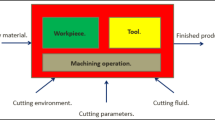Abstract
Cast aluminum alloy A380 is one of the most commonly specified alloys that has light weight and exhibits excellent resistance to hot cracking, which makes it necessary in many industrial applications. An idea is investigated to generate a cylindrical bushing without significant petal formation and radial fracture that are expected to be obtained by friction drilling of cast metals. Three materials; namely, 316 stainless steel, Al6060 aluminum alloy, and red copper alloy are used in which each of them is located on the upper and lower surfaces of A380 workpiece, so achieving the idea of the functionally graded material. The process parameters were studied for reducing the resultant axial force, the gap between surfaces, and achieving a longer bushing without petal formation and radial fracture. Lower feed rate achieves minimum axial force and gap thickness with maximum bushing length for all material sandwiches. An optimized decision making by the help of fuzzy logic techniques is performed, revealing that red copper sandwich exhibits the optimal multiple performance characteristic index based on axial force, bushing length, gap thickness, and gap divergence.











Similar content being viewed by others
Abbreviations
- Np :
-
Normalized axial force, bushing length, gap thickness, or gap divergence for every experiment number p
- Xp :
-
Axial force, bushing length, gap thickness, or gap divergence for an experiment number p
- Xmax :
-
Maximum value of the axial force, bushing length, gap thickness, or gap divergence for all experiment
- Xmin :
-
Minimum value of the axial force, bushing length, gap thickness, or gap divergence for all experiment
References
Kaufman, J. G., & Rooy, E. L. (2004). Aluminum alloy castings: Properties, processes, and applications. Materials Park: ASM International.
El-Bahloul, S. A., El-Shourbagy, H. E., El-Bahloul, A. M., & El-Midany, T. T. (2018). Experimental and thermo-mechanical modeling optimization of thermal friction drilling for AISI 304 stainless steel. CIRP Journal of Manufacturing Science and Technology, 20, 84–92.
Miller, S. F., Tao, J., & Shih, A. J. (2006). Friction drilling of cast metals. International Journal of Machine Tools and Manufacture, 46(12–13), 1526–1535. https://doi.org/10.1016/j.ijmachtools.2005.09.003.
Lee, S., Chow, H., & Yan, B. (2007). Friction drilling of IN-713LC cast superalloy. Materials and Manufacturing Processes, 22, 893–897. https://doi.org/10.1080/10426910701451697.
Yang, L. D., Ku, W. L., Chow, H. M., Wang, D. A., & Lin, Y. C. (2012). Mar-M247, Haynes-230 and Inconel-718 study of machining characteristics for Ni-based superalloys on friction drilling. Advanced Materials Research, 459, 632–637. https://doi.org/10.4028/www.scientific.net/AMR.459.632.
Biermann, D., & Liu, Y. (2014). Innovative flow drilling on magnesium wrought alloy AZ31. Procedia CIRP, 18, 209–214. https://doi.org/10.1016/j.procir.2014.06.133.
Kaya, M. T., Aktas, A., Beylergil, B., & Akyildiz, H. K. (2014). An experimental study on friction drilling of ST12 steel. Transactions of the Canadian Society for Mechanical Engineering, 38(3), 319–329.
Urbikain, G., Perez, J. M., Lopez de Lacalle, L. N., & Andueza, A. (2016). Combination of friction drilling and form tapping processes on dissimilar materials for making nutless joints. Proceedings of the Institution of Mechanical Engineers, Part B: Journal of Engineering Manufacture. https://doi.org/10.1177/0954405416661002.
Nassar, K., Mahmod, W. E., Masria, A., Fath, H., & Nadaoka, K. (2018). Numerical simulation of shoreline responses in the vicinity of the western artificial inlet of the Bardawil Lagoon, Sinai Peninsula, Egypt. Applied Ocean Research, 74, 87–101.
Acknowledgements
The author would like to acknowledge Flowdrill Company—Netherlands for offering the needed tools. Also, she would like to acknowledge Shoman Company—Egypt for the valuable support in manufacturing the used thermal friction drilling machine.
Author information
Authors and Affiliations
Corresponding author
Additional information
Publisher's Note
Springer Nature remains neutral with regard to jurisdictional claims in published maps and institutional affiliations.
Rights and permissions
About this article
Cite this article
El-Bahloul, S.A. Friction Drilling of Cast Aluminum Alloy A380 Without Significant Petal Formation and Radial Fracture. Int. J. Precis. Eng. Manuf. 20, 45–52 (2019). https://doi.org/10.1007/s12541-019-00039-7
Received:
Revised:
Accepted:
Published:
Issue Date:
DOI: https://doi.org/10.1007/s12541-019-00039-7




